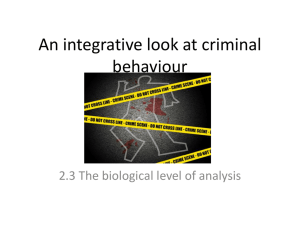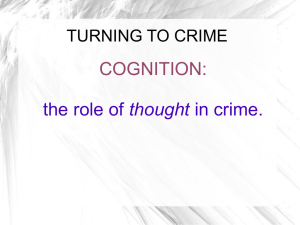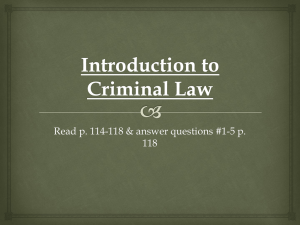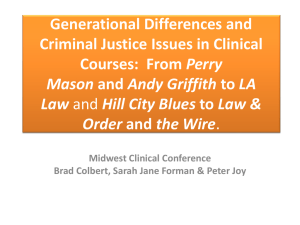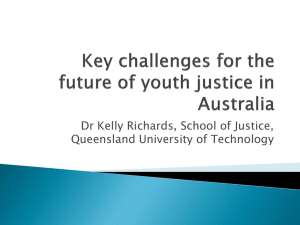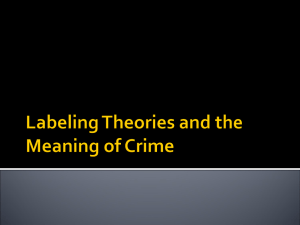EXPLANATIONS OF CRIMINAL BEHAVIOUR
advertisement
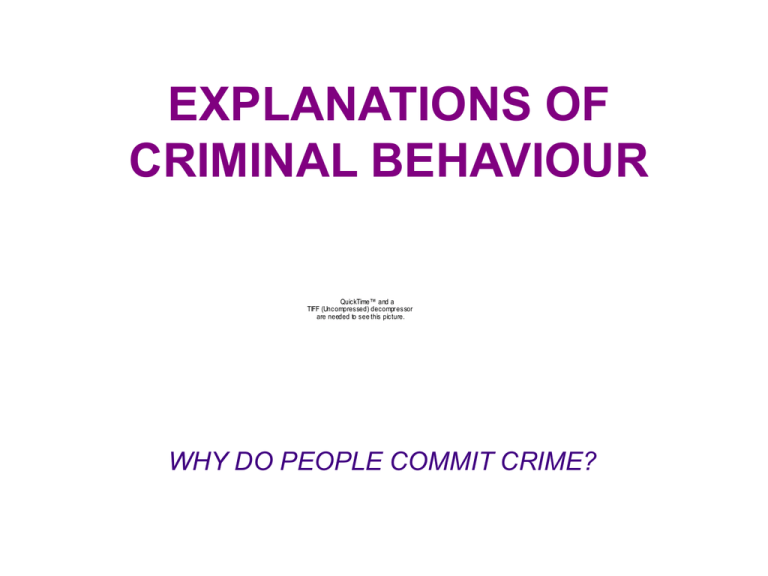
EXPLANATIONS OF CRIMINAL BEHAVIOUR QuickTime™ and a TIFF (Uncompressed) decompr essor are needed to see this picture. WHY DO PEOPLE COMMIT CRIME? * THEORIES of CRIMINAL BEHAVIOUR * • Nature or nurture? • PLOMIN (2001) - ‘Behavioural genetic research provides the strongest available evidence for the importance of environmental factors’, and most behavioural disorders reveal a genetic influence • Crime = Seductive (KATZ, 1998) • Crime = Addictive (HODGE et al, 1997) • Crime can give a buzz, risk of danger, fun PHYSIOLOGICAL THEORIES • • • Physical features, chromosomes, genetic transmission, neurological features - result of internal/innate characteristics LOMBROSO (1876) - Criminals more primitive than others, with distinguishing features, e.g. jutting jaw, low brow, flattened nose. SHELDON (1942) - Somatotypes Ectomorph - thin, shy, sensitive QuickTime™ and a TIFF (Uncompressed) decompressor are needed to see this picture. Endomorph - large, round, cuddly Mesomorph - Broad, athletic, CRIMINAL!!! TWIN STUDIES - GENETIC THEORIES • • • • • Good method for exploring genetic components Identical twins (MZ) share the same genes, non-identical twins (DZ) share approx. 50% of genes Similarities between twins can be distinguished as a result of genetic or environmental influences Studies carried out show MZ twins share more criminal tendencies than DZ twins - Nature, genetic EVALUATIVE ISSUE - Hard to find subjects willing to participate, and as most twins share same environment, it is difficult to distinguish differences. ADOPTION STUDIES - GENETIC THEORIES • • • • Alternative approach to twin studies to investigate genetic influence Adopted children showing similar behaviour to biological parents rather than adoptive parents suggests strong genetic link MEDNICK et al (1987) - boys whose biological parent had a criminal record were more likely to have been convicted than boys whose adoptive parent had a criminal record. BOHMAN (1995) found there was more chance of criminality when there was a genetic risk factor together with an environmental factor… Biological Parents have criminal record Biological Parents have NO criminal record Adoptive Parents have criminal record Adoptive Parents have NO criminal record 40% 12% 7% 3% PSYCHOLOGICAL THEORIES • • Personality EYSENCK & GUDJONSSON (1989) - Neuroticism & Extroversion linked to anti-social behaviour EXTROVERT Most Likely STABLE NEUROTIC Least Likely INTROVERT • Later added Psychoticism, marked by cold and aggressive behaviour PSYCHOANALYTIC THEORIES • • • BOWLBY (1944) - Maternal deprivation can have an adverse affect on the child - can lead to deviance and criminal behaviour Based on FREUD - Dysfunctional families can cause damage to superego and conscience - poorly developed superego = lack of control over anti-social impulses and a lack of guilt - unacceptable behaviour __________________ In contrast, KOLUCHOVA (1991) describes boys whose mother died shortly after birth - they were fostered for a while then went back to biological father, whose new wife kept them locked in a cage for 5 years - contrary to BOWLBY’s suggestion, the boys led a successful life, with no erratic behaviour etc SOCIAL LEARNING THEORIES • • • • CRIME = A product of learning SUTHERLAND (1939) - Individuals socialising with groups who regularly offend learn and follow their criminal behaviour BANDURA (1977) - Children learn from watching role models, e.g. parents, siblings, TV stars. Reinforcers also play a part in learning. DESENSITISATION = People are so used to seeing crime and violence on TV/films, they see it as the norm * INDIVIDUAL & CUTURAL DIFFERENCES IN CRIMINAL BEHAVIOUR * GENDER • • • Men found guilty of 80% of crime, women only 20% Types of crime are different - 80% of women commit fraud or theft, whilst men commit a much wider range of crimes May be a bias in the reporting of crimes - men who have had women catch them for fraud may be embarrassed to report this AGE • HOLLIN (2001) - Delinquency increases from age 8 until 16/17, then decreases in early 20s. FARRINGTON (1953) Parental influences/upbringing • • • Longitudinal study, 411 working-class boys, to see how lifestyle affected likelihood of becoming a criminal. 20% had convictions by age 17, 33% had convictions by age 25 Offenders showed common characteristics Young mother Erratic/harsh parental discipline Drink, smoke, gamble • Aggressive QuickTime™ and a TIFF ( Uncompressed) dec ompressor are needed to see this picture. More likely to have criminal parents Poor, large family Having criminal parents increases likelihood of re-offending CULTURE • • • • • In the UK and USA, more Afro-Caribbean and black African people are in prison than other ethnic groups REINER (1993) - Possible to say that black crime could be a result of racism RUSHTON (1990) - Blacks are more likely to be involved in crime due to genetic inferiority Ethnic groups may commit more crimes because they are at a social disadvantage Ethnic groups may be biased against when being convicted due to INSTITUTIONAL RACISM * SOCIAL PSYCHOLOGY OF THE CRIMINAL * • • • • • • • • Explains behaviour in terms of the social process that can affect the likelihood of criminal activity ZIMBARDO (1970) - Conditions such as anonymity or involvement within a group can cause DEINDIVIDUATION Deindividuated people feel that they don’t stand out, so may be tempted to do things they would not usually do - crime. -------------------------------------Young women(in groups of 4) gave electric shocks to 2 others - one pleasant, one unpleasant, who could be seen through 1-way mirror In some groups, women’s appearances were concealed and given numbers instead of names - deindividuated In the other groups, women were called by their names and made to feel special - individuated Deindividuated women gave twice as many shocks to both victims than the individuated women CONCLUSION - If people are made to feel anonymous, they have the potential to do harm to others
